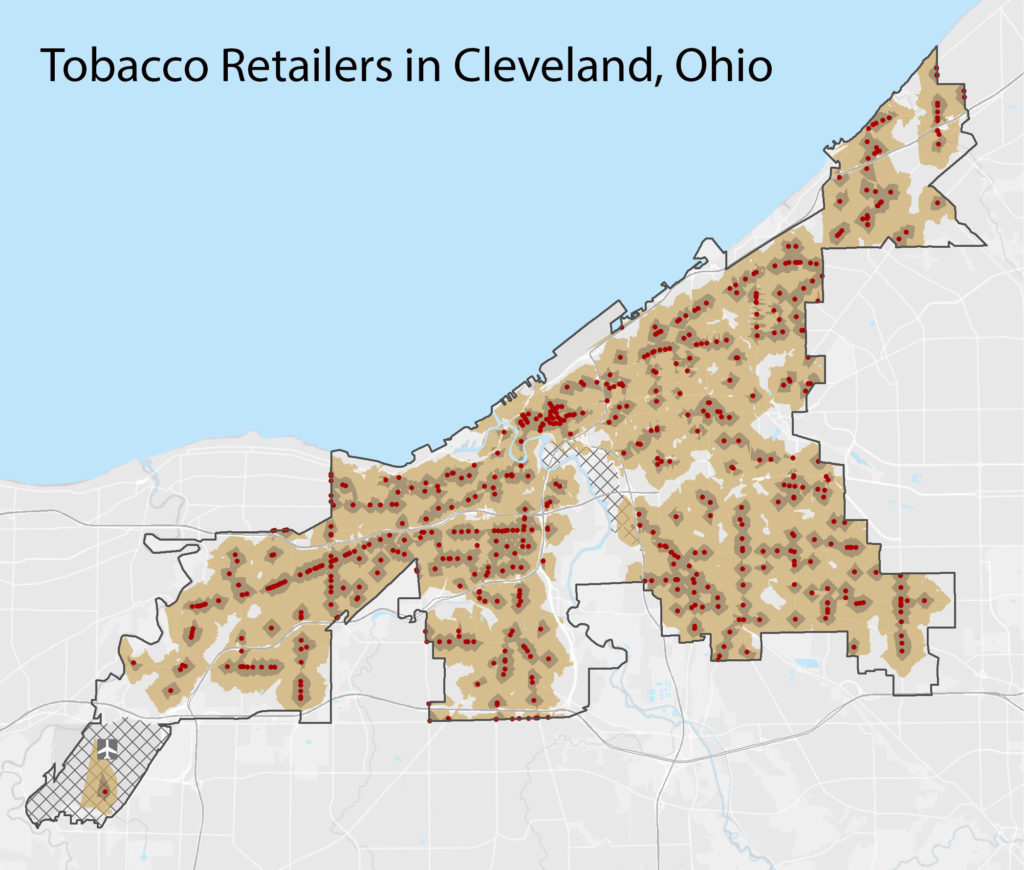More, densely packed tobacco retailers make for less-healthy behaviors
More, densely packed tobacco retailers make for less-healthy behaviors

Red dots represent tobacco retailers, and brown-shaded areas are “tobacco swamps,” areas with a glut of tobacco retailers. Cleveland residents who live in these areas reside within ½ mile of a tobacco retailer. Tobacco Swamps Maps for 30 U.S. cities are available at aspirecenter.org.
There are 27 brick-and-mortar tobacco retailers for every one McDonald’s restaurant in the U.S., equaling 375,000 tobacco retail locations. Retailers are not equally distributed, but tend to be clustered in lower-income and minority communities. New research concludes that living near more tobacco retailers is linked with people being more likely to use tobacco and less likely to quit. The findings suggest that decision makers can improve public health through policies that limit the number of stores selling tobacco products and how close those stores are to each other.
The analysis, published in the international journal Tobacco Control, examined and statistically combined the results of 27 studies of tobacco retail density, adult tobacco use, and health outcomes from 8 countries: Australia, Canada, Denmark, England, Finland, New Zealand, Scotland, and the U.S. The authors found that lower tobacco retailer density was associated with a 2.6% reduction in the risk of tobacco use behaviors. The study also explored differences in results by gender, income level, and intensity of tobacco use.
“Broadly speaking, implementing policies that reduce the number and concentration of stores selling tobacco could decrease smoking by between 2 and 3 percent among adults,” said the lead author, Joseph Lee, Associate Professor of Health Education & Promotion in the College of Health and Human Performance at East Carolina University. Senior author, Lisa Henriksen, a Principal Investigator of the ASPiRE Center and Senior Research Scientist at Stanford Prevention Research Center noted, “This paper strengthens the evidence that addressing the oversupply of tobacco products is an important strategy for preventing cancer and improving health.”
Tobacco use continues to be the leading preventable cause of death in the U.S., with 480,000 deaths and over $300 billion in healthcare spending and productivity losses caused by cigarette smoking each year. Tobacco retail stores are heavily concentrated in certain areas, particularly in low-income neighborhoods. “We know higher retail density is associated with increased tobacco product use and higher rates of youth initiation,” noted Kurt Ribisl, a Principal Investigator of the ASPiRE Center and Jo Ann Earp Distinguished Professor at the UNC Gillings School of Global Public Health.
Lee and the other authors from the University of North Carolina at Chapel Hill, Washington University in St. Louis, and Stanford University School of Medicine are members of the ASPiRE Center (Advancing Research and Practice in the Retail Environment), an NIH-funded research collaborative working to build a strong scientific evidence base for effective policies in the retail environment. ASPiRE researchers investigate how retail reduction strategies and other innovative retail tobacco interventions impact people and communities. The ASPiRE Center works to counteract the nearly $1,000,000 per hour the tobacco industry spends promoting its products.
